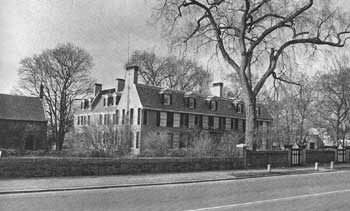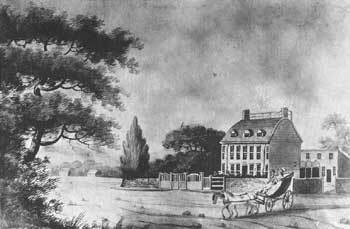






Survey of
Historic Sites and Buildings
 |
Adams National Historic Site Massachusetts |
 Adams National Historic Site |
| ||
Featuring the Adams Mansion, this site is a memorial to four generations of the distinguished Adams family, who resided in it from 1788 until 1927.
John Adams (1735-1826), signer of the Declaration of Independence, diplomat, the first Vice President, and the second President, founded a long line of men who were outstanding in politics and intellectual life, John Quincy (1767-1848), his son, won fame as a diplomat, U.S. Congressman, Secretary of State, and sixth President. Charles Francis Adams (1807-86), son of John Quincy, became a U.S. Congressman, diplomat, and author. His four sons—John Quincy II (1833-94), Charles Francis, Jr. (1835-1915), Henry (1838-1918), and Brooks (1848-1927)—made notable marks in politics, literature, and historiography.
 |
| Adams National Historic Site. (National Park Service, Frear, 1974.) |
The Adams Mansion, named "Peacefield" by John Adams but known to some as the Vassall-Adams House and later to the Adams family as the "Old House," was dear and close to all of them. In 1730-31 Maj. Leonard Vassall, a wealthy West Indian sugar planter who had come to Massachusetts some 8 years before, built the oldest part of the building. Comprising the front western section of the present residence, it was a 2-1/2-story frame structure of Georgian design with clapboarded walls and gambrel roof. The first floor contained two rooms separated by a central stair hall; the second floor, two bedrooms and center hall; and the dormered attic, three smaller chambers. The kitchen and servants' quarters were detached.
John Adams, while still Minister to Great Britain, bought the house in September 1787 from Vassall's grandson, Leonard Vassall Borland, and on his return the next year took possession. At that time, he apparently attached the 2-1/2-story kitchen and servants' quarters to the rear, or northwest, corner of the main structure. In 1800, near the end of his Presidency, he doubled the size of the residence by adding a large, 2-1/2-story, L-shaped wing of frame at the eastern end. It was constructed in the same Georgian style as the original house and contained on the first floor a second entry hall and staircase and the "Long Room" to the east of the hall. Adams' large study-library was on the second floor.
Other additions were made in the 19th century. In 1836 John Quincy Adams built the passage along the back, or north, side of the structure connecting the two rear service ells. In 1869 Charles Francis added 30 feet to the kitchen ell for additional servants' quarters; the following year, a detached stone library overlooking the garden; and in 1873, the stone stable. Brooks constructed the present entrance gates in 1906.
 |
| "Peacefield" in 1798. (Watercolor, 1798, by E. Malcolm, Adams National Historic Site.) |
After retiring from the Presidency in 1801, John Adams lived in the house year round until his death in 1826. Subsequently, until Brooks' death in 1927, other family members resided in it full time or spent their summers there. The furnishings, to which each generation contributed, reveal the continuity of life in the residence and the tastes of the Adams family.
In 1946 the Adams Memorial Society donated the property to the Federal Government. Consisting of almost 5 acres, it includes the well-maintained house, library, garden, and stables.
 |
 |
http://www.cr.nps.gov/history/online_books/presidents/site29.htm
Last Updated: 22-Jan-2004